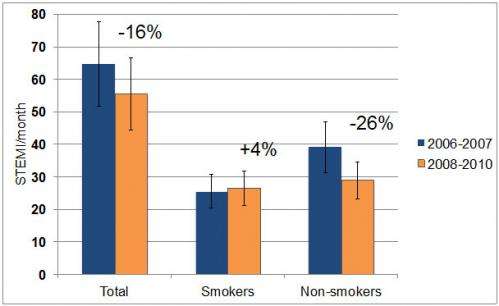Non-smokers benefit most from smoking ban: study

After the smoking ban was introduced in Bremen, Germany, the rate of ST-elevation myocardial infarction (STEMI) diminished by 26% in non-smokers but remained almost constant in active smokers, according to research presented today at the ESC Congress 2012. The results were presented by Dr Johannes Schmucker from Germany.
Many European countries have passed anti-smoking legislation which bans smoking from restaurants, bars and public buildings. After implementation of such a smoking ban on 1 January 2008 in the metropolitan area of Bremen in northwest Germany (800,000 inhabitants) a 16% decline in ST-elevation myocardial infarction (STEMI) was observed. STEMI is the severest form of myocardial infarction.
For the study, 3,545 STEMIs in the Bremen-STEMI-Registry which occurred between 2006 and 2010 were analyzed. Figure 1 shows the average number of STEMIs per month in the total population, smokers and non-smokers in 2006-2007 and 2008-2010. Dr Schmucker said: "There were more non-smokers than smokers, which explains why the non-smokers group had more STEMIs registered."
For the total population in 2006 and 2007, before the smoking ban was passed, averages of 65 STEMIs were registered per month. In 2008 to 2010, after the smoking ban was passed, the number fell by 16% to an average of 55 STEMIs per month. "This confirms that the smoking ban had a positive impact on the population as a whole by decreasing the number of STEMIs," said Dr Schmucker.
A nearly constant rate of STEMIs was observed in active smokers during 2006-2010. In 2006-2007 active smokers had an average of 25 STEMIs per month. In 2008-2010, they had an average of 26 STEMIs per month, a 4% increase. Dr Schmucker said: "Active smokers are inhaling such high doses of tobacco smoke that being exposed to less passive smoke in public venues is not going to change the risk for that particular group."
In non-smokers there was a 26% decrease in STEMIs, from an average of 39 STEMIs per month in 2006-2007 to an average of 29 STEMIs per month in 2008-2010. The steepest decline in the non-smoking group was detected in young non-smokers; in this group the average number of STEMIs per month was 31% lower in 2008-2010 compared to 2006-2007.
"The reduction in the occurrence of this severest and deadliest form of myocardial infarction in the metropolitan area of Bremen can be partially attributed to the commencement of anti-smoking legislation," said Dr Schmucker. "Non-smokers and especially non-smokers under the age of 65 benefited most from the implementation of the law, indicating the harmful effects of passive smoking. This suggests that expanding anti-smoking legislation could reduce the occurrence of STEMIs even further in the future."














